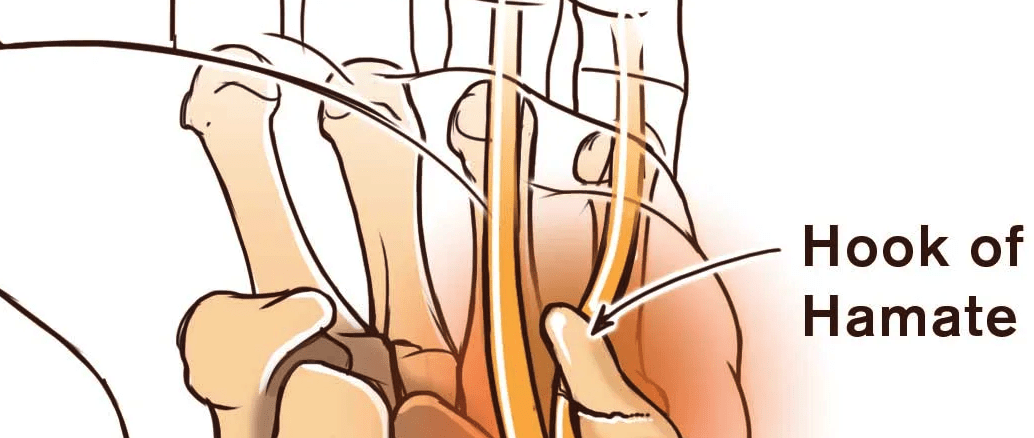Hook of Hamate fractures
The Hook of Hamate fracture is typical in athletes.Hook of hamate fractures are rare, often missed, injuries generally as a result of a direct blow to the hamate bone most commonly seen in athletes.Diagnosis is confirmed with either a radiographic carpal tunnel view or CT scans.
Incidence: 2-4% of carpal fractures. More common in men. Usually seen in athletes in sports requiring gripping like golf, baseball and hockey.
It happens when the rigid handle is struck against the palm or when falling onto an outstretched hand.
The Hamate bone is in the centre of the wrist towards the little finger (ulna) side. A bony extension of the Hamate bone pushes up into the palm called the Hook of Hamate because it is shaped like a hook.
When the Hook of Hamate is fractured, the key symptoms are localised pain, tingling in the little and ring finger, and pain when flexing the little finger. The pins and needles are related to the proximity of the ulnar nerve, which runs very close to the hook of Hamate.
Hook of Hamate fractures do not often show on plain x-rays and are mainly identified on MRI or CT scans.
Treatment is either observation, surgical excision, or surgical fixation depending on the severity of the symptoms and activity demands of the patient.
The treatment of these fractures varies depending on the occupation and functional demands of the injured person. In the case of professional sportspeople, we often recommend surgical excision of the hook of Hamate to facilitate a rapid return to play. However, in non-elite sportspeople, we recommend a period of splint immobilisation and then return to play. If there is still discomfort and aching over the hook of Hamate after several months, we recommend surgical excision at this stage.
Surgery is successful and is performed under general anaesthetic as a day case.
Careful surgical dissection is required to identify the hook projection and protect the nearby all that nerve and long flexor tendons to the little finger.
Usually, professional athletes can return to competitive play somewhere between two and six weeks, depending on their specific activities.
Complications of the hook of hamate fracture
- Non-union: incidence (most common), 50% rate of non-union
risk factors
considered natural course of fracture given fracture site motion and poor blood supply
- Ulnar nerve neuritis in Guyon’s canal
Incidence
20% rate of ulnar neuropathy
Treatment
hook of hamate excision
- Closed rupture of the flexor tendons to the small finger
incidence
very rare (only case reports)
- Weakened grip strength
Risk factors
excision of large hook of hamate fractures
Prognosis
High non-union rate with conservative management (up to 50%)


